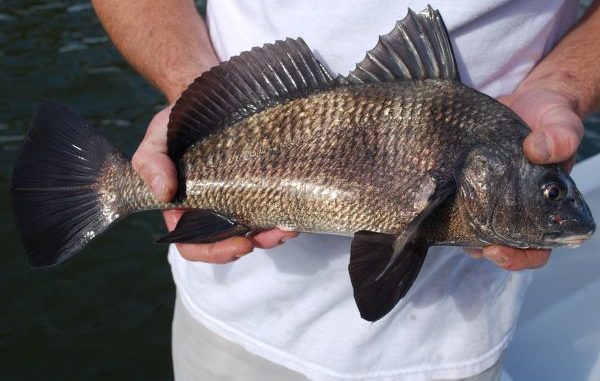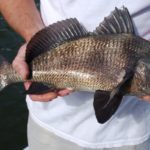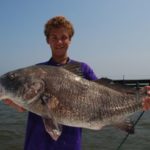
Black drum are an underrated recreational fish, certainly when their quality as table fare is considered. A few visits to Louisiana’s fabled Creole restaurants, where the fish is on almost every menu, should convince even a skeptic of that.
Since redfish were declared gamefish and the harvest of speckled trout has become severely restricted, black drum have really stepped, er, swum up to the plate.
While recreational fishermen ignore them and restaurant diners adore them, oyster farmers utterly abhor them. If a school of black drum is present when an oyster farmer is spreading small seed oysters on his reef, they can almost wipe his work out.
Small black drum are not the problem. Very few oysters appear in the diet of black drum under 12 inches long. These small fish eat insects, worms, shrimp and small crabs.
By the time drum reach 12 to 16 inches long, however, oysters are found in five percent of their stomachs. In drum larger than 16 inches, predation on finfish and large crabs sharply rises — but the consumption of oysters skyrockets.
Laboratory research shows that a large black drum will consume one oyster per pound of body weight per day. A 20-pound drum can eat 20 oysters each day!
Over the course of the year, this can be a substantial amount of oysters, especially when one considers the large number of drum present in coastal Louisiana. At the height of the gill-net fishery, almost 11 million pounds of black drum were harvested by commercial and recreational fishermen combined, yet barely a dent seemed to have been made in the drum population.
Black drum have plenty of firepower to shuck the oysters they eat, using massive pharyngeal teeth located in the back of their mouth as their main weapon. Watching large black drum feed on oysters is an impressive sight.
They swim with their heads slightly lowered, drifting their barbells (chin whiskers) over possible food items. When the barbells touch a food item, the drum stops swimming and inhales the food item by creating a suction with its gill covers and mouth.
The drum then slowly swims forward while crushing the food item with its pharyngeal teeth.
As the food item is crushed, small shell particles fall from the drum’s gills. After finishing, the drum ejects the rest of the shell from its mouth in a cloud of debris.
An oyster never has a chance. Black drum can break apart and crush oyster clusters, but seem to select singles for ease of feeding.
Black drum feed both during daylight hours and at night, but feeding is less intensive during early morning hours unless they happen to locate an oyster farmer bedding seed oysters.
While feeding, especially on soft bottoms, schools of black drum often dredge up the bottom and create large, muddy plumes in the water that can be easily seen from the air or, with trained eyes, even from a boat.
Part of the knock on black drum is a somewhat exaggerated reputation for carrying infestations of worms in their flesh. Often called “spaghetti worms,” the worms are really parasitic tapeworms of sharks that are using the drum as an intermediate host. If the drum is eaten by a shark, the larval worm becomes a reproducing adult in the shark.
While the worms might look unappetizing, they are harmless to humans, even if not cooked.
The worm is very similar to, if not identical to, the spaghetti worm found in speckled trout. As with trout, fish from one locality are often much more likely to be harboring the worm than are fish from another spot.
Generally speaking, drum taken from clear, high-salinity waters are more likely to carry the worm. The reasons for this are unknown, but probably related to the environmental demands of the worm’s other intermediate hosts.
Black drum over 10 or 15 pounds, called “bull drum,” from areas of high worm incidence can indeed carry so many spaghetti worms in their flesh, especially near the tail, that they are difficult to find appetizing at all.
However, bull drum from other areas and smaller fish, called “puppy drum,” carry few or no worms, and are excellent on a plate.
Twenty five years of tagging work in Texas reveal that black drum tend to be homebodies. Over the two-and-a-half-decade period, the black drum recapture rate was 3 percent.
Nearly 80 percent were caught in the same bay where released, 12.7 percent in other bays, and 2.4 percent were tagged in bays and recaptured in the Gulf.
One was released in the Gulf and ecaptured in a bay. Two black drum were both released and recaptured in the Gulf.
Two fish were tagged in the Lower Laguna Madre and recaptured in Mexico.
Recaptured black drum traveled from 0 to 227 miles, and averaged 14.4 miles. Most (68.6 percent) were recovered within 12 miles of their release site. Almost 22 percent of the black drum were recaptured at the same site as their release.
The longest that any fish was free was 6,309 days (17.3 years).
Black drum are managed recreationally with a five-fish daily limit and a 16-inch minimum length. Only one fish over 27 inches long may be taken as part of the limit.
Commercial fishermen also have a 16-inch minimum length, as well.




